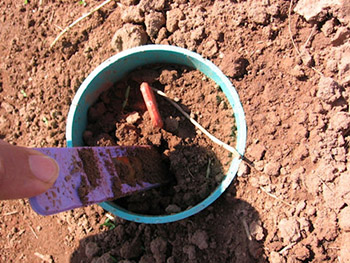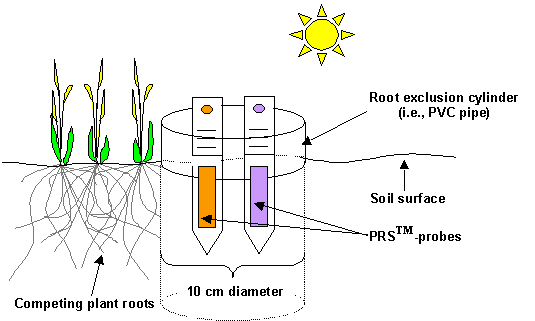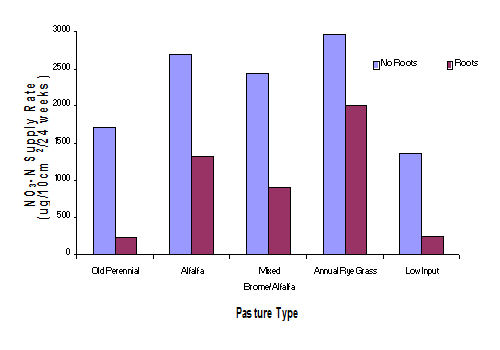PRS Technology

Installing PRS® Probes into Root Exclusion Cylinders.
When burying the PRS® Probes for extended periods, the effects of interspecific competition from plant roots need to be considered. When buried among plant roots, the PRS® Probes will provide a net nutrient supply rate (i.e., measuring the difference between total soil nutrient supply and plant uptake); therefore, yielding a measure of nutrient surpluses rather than net mineralization over the burial period. Depending on the research objective this may be desirable; however, if wanting to measure the effects of net mineralization on nutrient supply, then employing a root exclusion cylinder is required (Below). Care should be taken to remove plants growing within the cylinder over the burial period. Following a heavy rain, ponding of water may occur within the PVC pipe leading to denitrification and lower N supply rates. To prevent this from occurring, make sure to level the PVC pipe with the ground and/or simply drill drainage holes in the sides of the exposed PVC pipe. Although studies have shown that the use of PVC pipes have no significant effect on edaphic properties or nutrient cycling processes, if their use is impractical, then cut a deep (i.e., 30 cm) slit around the PRS® Probes with a radius of at least 20 cm. This will work to effectively prevent root competition in a similar manner; however, this procedure will need to be repeated at least once every two weeks to a month.
Note: Large microscale variations in supply rates may be observed when PRS® Probes are buried with root competition due to differences in numbers and proximity of roots at different locations.
Below: Root exclusion cylinder used for isolating PRS® Probes from plant root competition during long-term in-situ burials.

Some researchers use a combination of PRS® Probe burials with/without root competition to gain a more complete understanding of total nutrient release, plant uptake, and nutrient surpluses. The difference between nutrient supply rates within a root exclusion cylinder and those measured outside the cylinder can be used as an index of plant nutrient uptake (Huang and Schoenau, 1997). However, the presence of roots may have secondary effects (i.e., rhizosphere effects) on nutrient availability, which the PRS® Probes are incapable of reproducing. For example, when N-fixing plants are involved, the additional N fixed by plants outside of the cylinder will greatly affect the relationship between N supply rates measured inside and outside the root exclusion cylinder and plant uptake.
The impact of plant root competition on soil nutrient supplies measured over a growing season is shown in the following table:
Table & Figure: Impact of plant roots on cumulative NO3--N ion adsorption by PRS Probes buried in different pasture systems biweekly (12 times) over a growing season at Lacombe, Alberta 1999. Data courtesy: Dr. Vern Baron, Agriculture & Agri-Food Canada Research Center, Lacombe, Alberta.
| Pasture Type | No Roots | Roots | N Uptake |
| μ NO3- 10cm-2 week-1 | kg ha-1 | ||
| Old Perennial | 1713 | 237 | 140 |
| Alfalfa | 2686 | 1328 | 330 |
| Mixed Brome/Alfalfa | 2446 | 896 | 320 |
| Annual Rye Grass | 2955 | 2007 | 200 |
| Low Input | 1349 | 262 | 140 |
| Significant F | ** | ** | * |
| SE LSMeans | 185 | 165 | 40 |

This data shows that PRS® Probe NO3--N supplies were much lower in the presence of roots. By burying PRS® Probes both inside and outside of the cylinders, a more complete picture of soil nutrient dynamics can be obtained.
Plant roots are not the only ion sinks requiring consideration. Similarly, microorganisms remove ions from the available soil nutrient pool, thereby competing with the PRS® Probes for nutrient ions, resulting in reduced nutrient supply rates. For example, if a soil is amended with material having a wide C:N, C:P, or C:S ratio, then soil microorganisms will be competing with the PRS® Probes for available nutrients. However, it is important to remember that this nutrient competition is similar to that experienced by the plant root. Burying the PRS® Probes in plots with/without the imposed treatment will provide a more complete picture of soil nutrient dynamics following any amendment.
